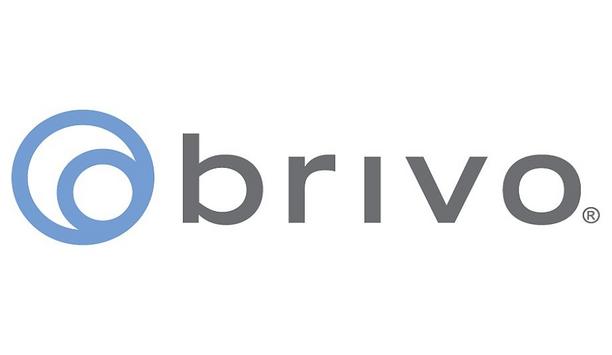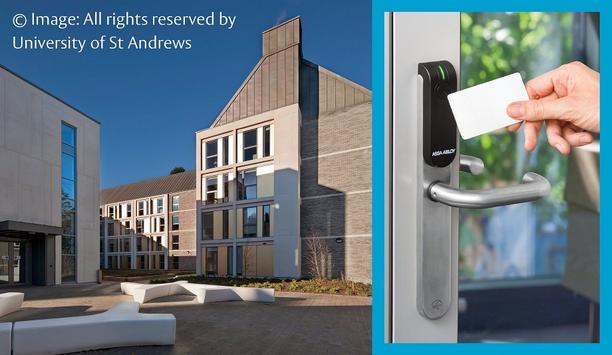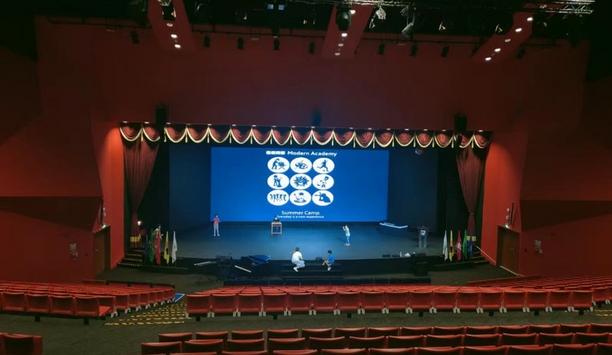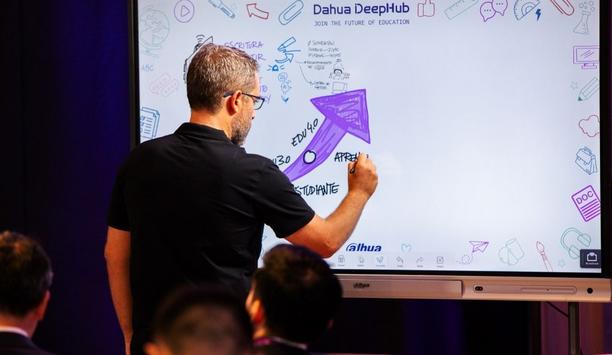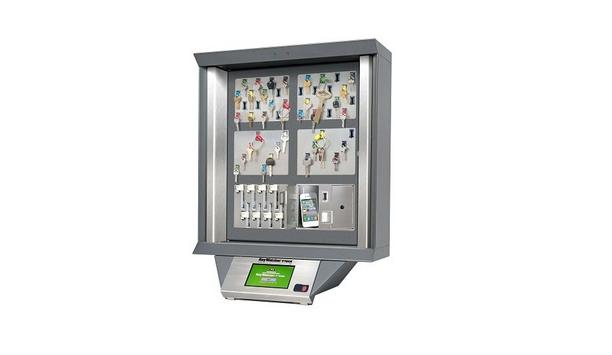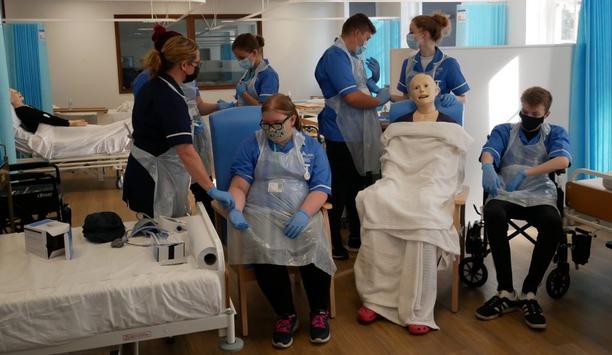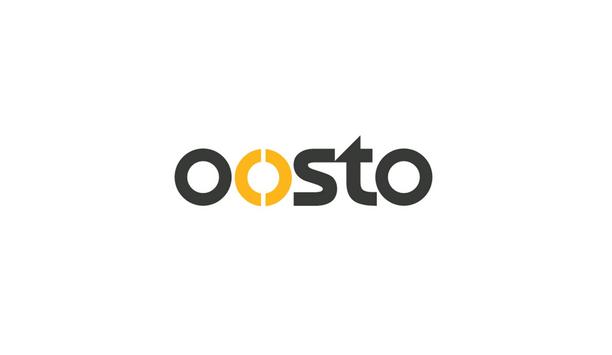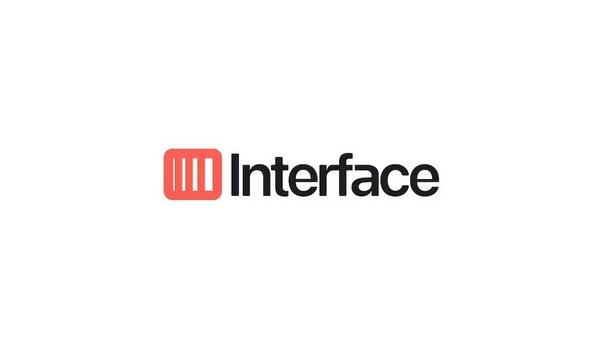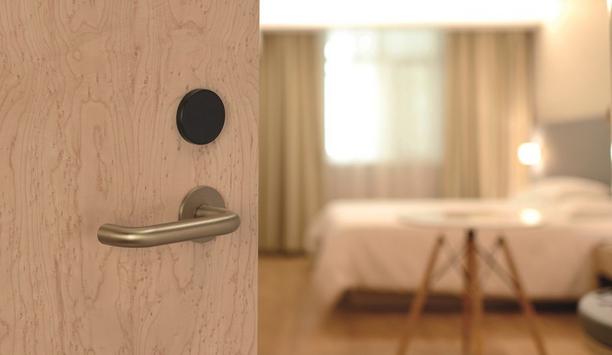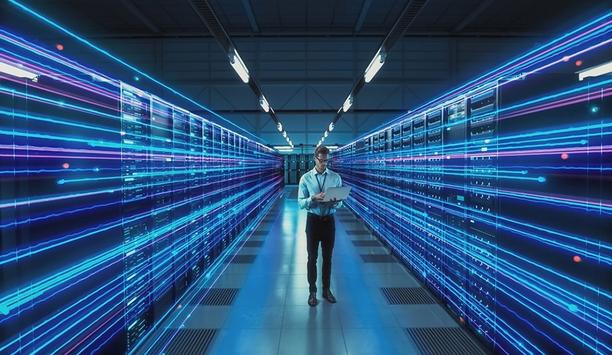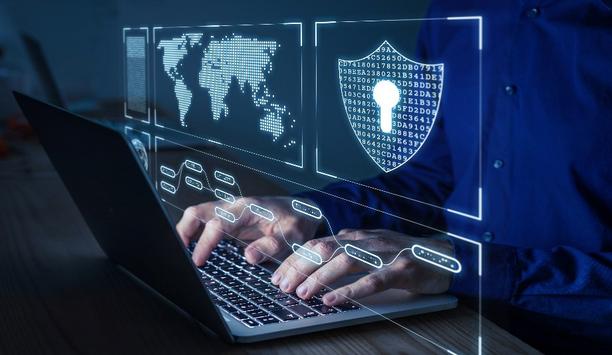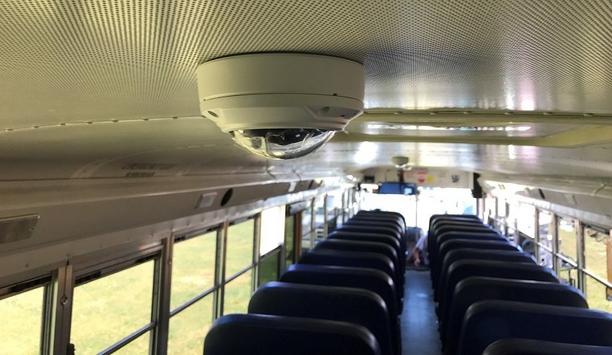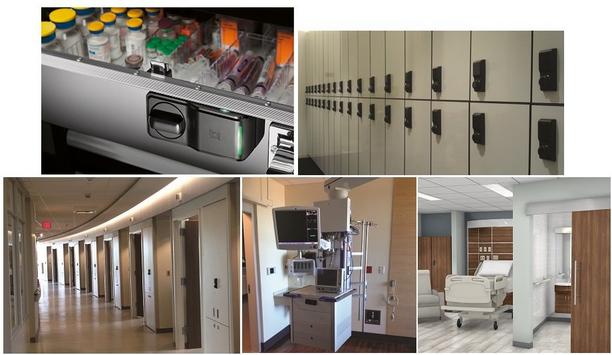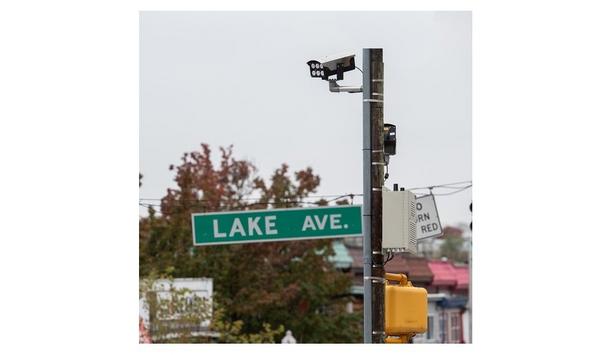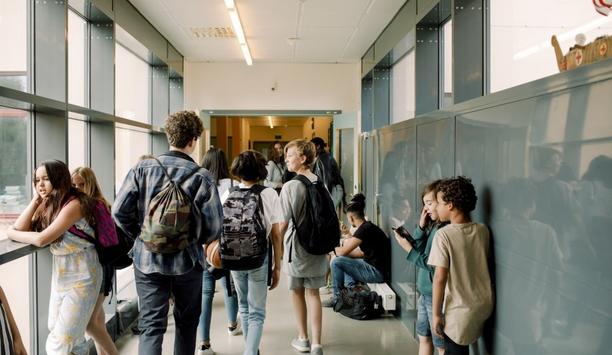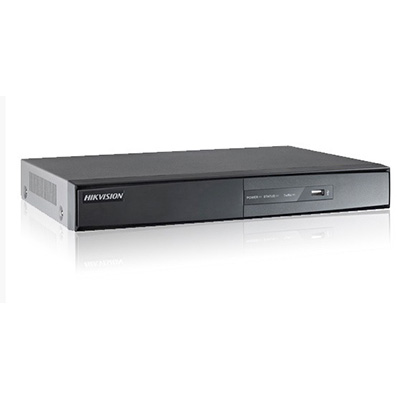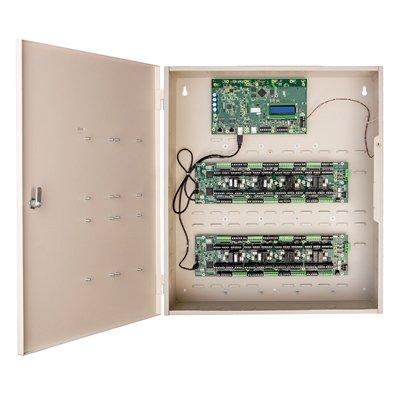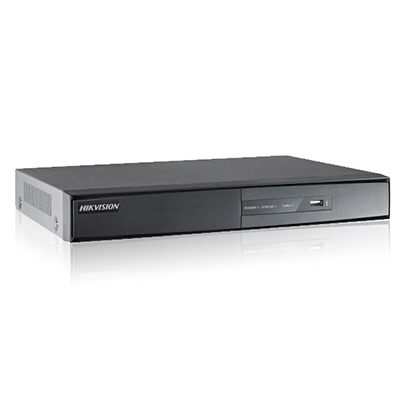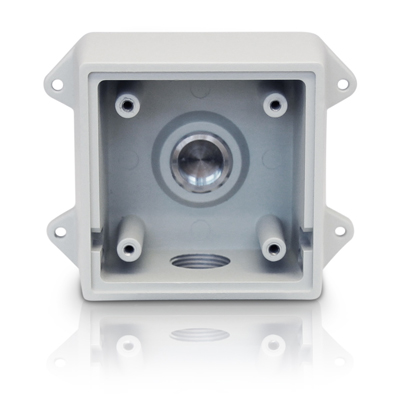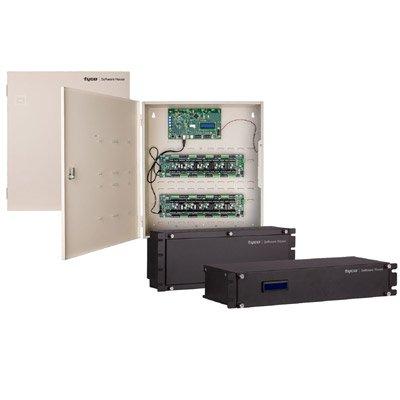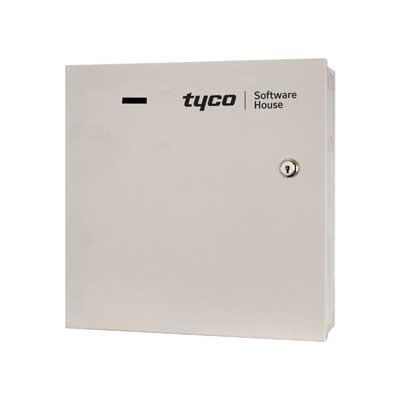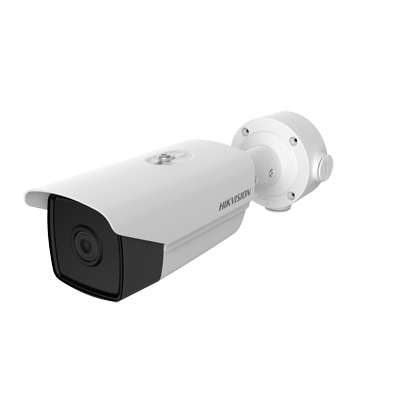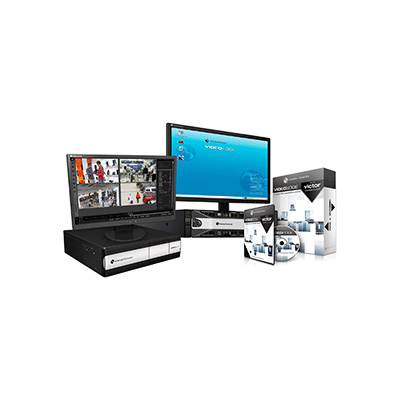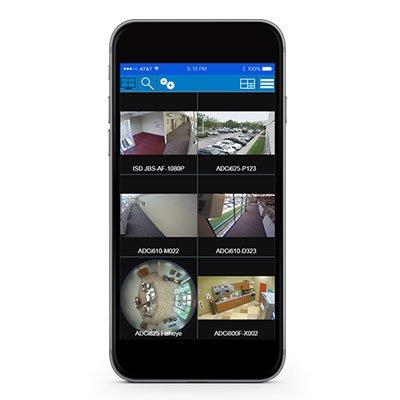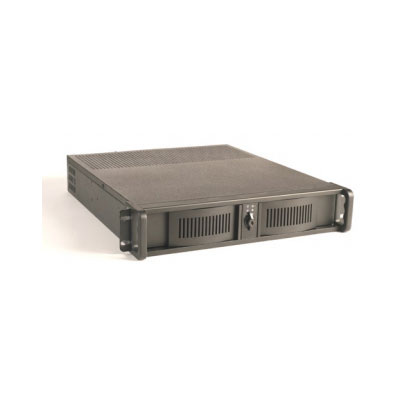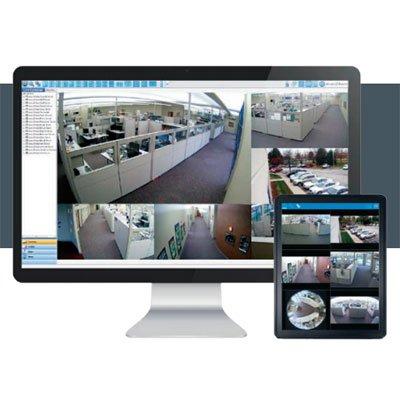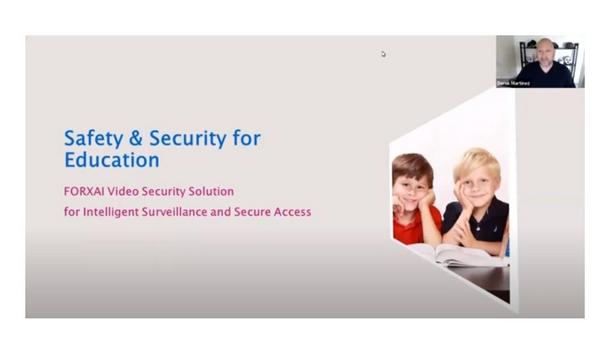Education security applications
Central Community College in Nebraska has multiple campuses and educational centers to serve approximately 90 different communities. CCC’s outdated lock-and-key system and access control technology weren’t meeting their security needs. On one campus alone there are 26 buildings with access control needs for students, staff, and vendors. The security team had to provide targeted scheduled access control for about 15 different user groups. Support and service “From past...
In Neuss, Düsseldorf, and Meerbusch, ISR (International School on the Rhine) offers an excellent international education from kindergarten to grade 12. The teachers at ISR prepare students for the world's most prestigious universities, placing great emphasis not only on academic excellence but also on positive character development and the teaching of values. Since 2022, ISR has also been using the DeepHub whiteboard for this purpose. Test phase from 2022 "The modernization o...
Founded in the early 1400s, the University of St Andrews is globally renowned and was recently ranked as the UK’s top university. It occupies around 150 separate buildings in and around the town of Fife, Scotland. Home to the St Andrews Prize for the Environment, it has many teams and departments that have won awards for sustainability, energy efficiency, and environmental action. The University’s vision is to be net zero by 2035. St Andrews will take out all avoidable greenhouse ga...
In order to turn its auditorium into a multi-purpose venue, and to improve the general visual experience, Dubai's GEMS Modern Academy replaced their legacy projection system with a massive LED wall from Hikvision. The renovated auditorium has become a popular venue for students, staff, and the community. Challenge: Turning the school auditorium into a multi-purpose performance venue. With the numerous approaches to the entertainment available, and with audiences' surging demand for rich, high-q...
The Commonwealth of Puerto Rico needed to implement a centralized and efficient perimeter security system for all public schools on the island. Intrusions and assaults at educational institutions have increased, and Hurricane Maria further exacerbated problems with the destruction of infrastructure. The solution: The need to repair hurricane damage also provided opportunities to invest in modern improvements. The Department of Education chose to install a video surveillance system with more th...
AI is empowering a new generation of advanced, efficient security systems. In the field of education, AI is also facilitating the digital and intelligent upgrading of schools and institutions from K12 to universities. AI applications such as smart identification, deep learning and intelligent analysis greatly reduce manpower costs, while improving the security level and management efficiency at the same time. AI-enabled innovative teaching methods can help enhance engagement in both remote and...
News
Morse Watchmans, the industry pioneer in key control and asset management systems, reports a rising number of domestic universities installing the company’s flagship key control system, KeyWatcher® Touch, to facilitate heightened levels of security and safety on campus. KeyWatcher Touch systems Recently, Morse Watchmans reports new, multi-department deployments of its KeyWatcher Touch systems at Boise State University and Marquette University. Additional higher education facilities, including the University of Michigan, Ohio State University, Yale University, University of Texas, and University of California have recently expanded or upgraded their existing KeyWatcher Touch systems with many others having placed or plan to place orders for fulfillment in 2023. First-of-its-kind key control solution KeyWatcher Touch improves university security while reducing costs related to theft, loss, and re-keying" “We are witnessing universities across the country embrace our first-of-its-kind key control solution because it allows departments of all types to manage campus security in a specific, yet highly integrated manner across the campus enterprise,” said Tim Purpura, VP of Global Sales and Marketing, Morse Watchmans. “Moreover, KeyWatcher Touch improves university security while reducing costs related to theft, loss, and re-keying, assuring campus security and facilities teams alike that their security investment offers tangible ROI.” Scalable key control solution Because KeyWatcher Touch systems are infinitely scalable, it is possible for universities to start with one system and add on more as needed. In this way, key control and asset management solutions fit the needs of departments and universities now and into the future. Morse Watchman’s KeyWatcher® Touch electronic key cabinet is a scalable key control solution for organizations looking to secure, manage and track keys and other assets. KeyAnywhere technology With a 7” touchscreen and patented SmartKey system with industry-first KeyAnywhere technology, it is easy to withdraw and return a key securely to any key cabinet located within an enterprise. KeyWatcher® Touch also integrates with many brands of access control systems for a layered security approach.
More than one million electric vehicles are registered in the U.S.—and they all have to plug in somewhere. As EV charging stations pop up across the country, one of the chief questions will be how charging station users are identified, authenticated, and connected with membership or payment systems. Radio-frequency identification cards and tokens and smartphone authentication apps have emerged as two viable options for EV charging authentication. Which is best? It may depend on the user base they plan to serve. User authentication for EV charging Most electric vehicle owners have a spot to plug in while at home, either in their own garage or carport or in a designated charging spot in a tenant parking garage. But electric vehicles also need spots to charge while owners are out and about. The EV charging market is broadly divided into two tiers: Level 2 charging stations, which operate at 208-240 V and use AC power. These stations will add 20-25 miles of range in about an hour of charging. The U.S. Department of Transportation listed more than 22,800 public Level 2 EV charging stations across the nation as of mid-2020. They are commonly found in public parking lots and garages, hotels, grocery stores, malls, and other commercial areas. They may also be installed in private parking garages and business parking lots for use by tenants, employees or fleet drivers. Collecting membership data Direct Current Fast Chargers (DCFS) are designed to charge an EV battery to about 80% in 20-30 minutes. There are currently about 15,000 DCFC stations across the U.S., but their numbers are expected to explode as more people start taking EVs on longer road trips. They are commonly found along major interstate highways. As the market evolves, user authentication requirements for EV charging stations are likely to vary by type, location, and user base. Some commercial locations may provide Level 2 EV charging as a free amenity to shoppers, guests or employees. If there is no charge for the service, there may be no need to authenticate users at all— people can simply park and plug at any available spot. However, there may be a benefit to collecting membership data (e.g., shopper reward club). Private charging stations Public, for-profit EV charging stations, like gas stations, need a method to collect payment for their services. In some cases (especially at roadside DCFS stations), users may simply pay for the minutes used with a credit card—just like at the gas station pump. However, many EV charging station users are already accustomed to identifying themselves with an RFID membership card or a smartphone app. Charging networks like ChargePoint and Blink enable members to access any EV charging station within their networks with a card or smartphone app, which connects to their membership, account, and payment information. Private charging stations—such as those offered to tenants, employees or fleet drivers—may not require payment but need to ensure that only authorized drivers are accessing power and taking up valuable parking spots. An RFID card or smartphone app can be used to identify authorized drivers and track charging behaviors. Moving forward, many EV charging stations may find that they need a mix of options for users, including membership cards, smartphone apps, and a credit card payment option for out-of-network drivers. Choosing between RFID and smartphone apps In the long run, the answer may be ‘both.’ RFID cards are economical and easy to issue When user identification and authentication are desirable, which is the better option: RFID cards or smartphone authentication? Both have their uses in the EV charging market. In the long run, the answer may be ‘both.’ RFID cards are economical and easy to issue. And for some users bases, they may not have to issue a new card at all—they can take advantage of an RFID card they already carry. In many cases, it is possible to leverage existing employee IDs and membership cards for access to privately controlled EV charging stations. RFID membership cards may be a good bet for: Fleet drivers who already carry an RFID card for vehicle access. Employee parking lots and garages where people already use a card for entry. EV charging parking spots at gyms or other locations where users want to limit charging access to active members. EV charging stations Most consumers would prefer not to have to carry a physical membership card for every retail outlet On the other hand, public charging stations may find that consumers would prefer to use a smartphone app rather than receive another membership card to carry in a physical wallet. Many consumers prefer to carry only their phone and one or two essential cards (such as a driver’s license and a single credit or debit card). As more retailers enable consumers to pay via a digital wallet app on their smartphones, some don’t even carry a physical credit card anymore. Most consumers would prefer not to have to carry a physical membership card for every retail outlet they visit—and that includes EV charging stations. Smartphone apps for user authentication are simple to set up and highly secure. Instead of RFID, they typically use either Bluetooth® Low Energy (BLE) or Near-field Communication (NFC) protocols. Public charging stations For the user, the experience is almost identical to RFID authentication, except they wave a smartphone over the reader instead of a card. Apps have other user benefits, too. A custom app for EV charging can be configured to help users locate or reserve charging stations, check their balance and usage history, and change their payment options right on their phone. These features make smartphone authentication ideal for consumers These features make smartphone authentication ideal for consumers accessing a network of public charging stations. However, EV charging network managers should keep in mind that some users may still want a physical membership card. Smartphone-Based authentication There are still some user populations, such as older consumers and those from lower income brackets, where smartphone ownership is not ubiquitous. If users are primarily using EV charging for a fleet vehicle, they may not want to download an application for work on their personal cell phone. Other users may find smartphone apps confusing or simply prefer to have a card for other reasons. The answer for both public EV charging networks and private charging station owners is to have an RFID reader that is capable of both card-based and smartphone-based authentication. This will provide maximum flexibility as user preferences change. Finding the right RFID reader for EV charging The ELATEC TWN4 MultiTech family of readers is ideal for authentication at EV charging stations The best RFID reader for EV charging is one that is flexible enough to meet the needs of all user populations and evolve as requirements change. The ELATEC TWN4 MultiTech family of readers is ideal for authentication at EV charging stations. The readers support 60+ RFID transponder technologies along with BLE and NFC smartphone authentication. This means that one reader can support all common technologies already in use across the entire user base—both nationally and internationally. This capability becomes important for applications where users want to enable drivers to use an existing RFID card (such as their employee or fleet ID card or an access card for a tenant parking garage) for access to charging locations. It also provides more flexibility as technologies or preferences change in the future. Supporting advanced encryption TWN4 MultiTech supports advanced encryption and security configurations for highly secure transactions between the card or smartphone and the reader. This is important for EV charging applications tied to payment or employee/driver identification. ELATEC readers are mobile-ready. The ELATEC Mobile Badge BLE NFC App offers simple and effective components for building or extending a mobile application for EV charging networks. Non-managed mobile credentialing using the ELATEC app is free. TWN4 MultiTech readers also work with multiple existing third-party managed credential systems, such as KleverKey, Safetrust, and Transact. The TWN4 MultiTech is easy to customize with the powerful Software Development Kit (DevPack) and App Blaster and Director utilities. Readers can be easily configured to support custom functionality (such as LED light flashing sequences or sounds for user feedback) and integration with backend software for easier member management. The DevPack tools make the TWN4 family the most powerful, versatile, and sustainable readers on the market. Hardware communication interfaces As electric vehicles move from niche to mainstream, EV charging infrastructure will need to grow and evolve to accommodate millions more drivers—both in the consumer market and in commercial fleets. With TWN4 MultiTech, EV charging station managers will be ready. Interested in learning more about technical considerations for RFID? Download 11 Considerations for Embedded System RFID Readers for additional advice, including operating power and consumption requirements, antenna placement, hardware communication interfaces, and more.
Mul-T-Lock has worked closely with K.B.O Fire & Security to upgrade the security at Guildford College, in the United Kingdom (UK), creating a dedicated master key suite for the ultimate peace of mind of staff, pupils and visitors. Guildford College is the largest further and highest education college in the Surrey area, with approximately 3000 students and offers courses at all levels. Success rates are higher than national benchmarks with many students operating with the local community on a regular basis. Control and secure access for Guildford College K.B.O Fire & Security offered a number of innovative ideas to ensure complete security Controlled and secure access is a high priority for the Estates and Facilities team, who sought the advice of K.B.O Fire & Security to undertake a comprehensive security overview. K.B.O Fire & Security offered a number of innovative ideas to ensure complete security and a smooth operating system throughout the college site. Mul-T-Lock’s high security MTL400 patent protected solution The resulting master key suite was designed and installed using Mul-T-Lock’s high security MTL400 patent protected solution, which combines advanced technologies with enhanced key copy control and maximum resistance to all forms of lock manipulation. Sandra Searle, the Facilities Customer Services Manager at Guildford College, said “The college is committed to offering staff and students a vibrant, happy and nurturing learning environment. So that we can do this as safely as possible, we ensure the security systems, right from the entrance to the college and throughout the site, are all maintained to a high level.” Bespoke Mul-T-Lock master key suite system Sandra Searle adds, “K.B.O Fire & Security worked with us to produce a bespoke Mul-T-Lock master key suite that could enable total key management control. We are particularly impressed with the advanced protection capability as it means as a team, we can maintain a single key to open all doors as required and maintain differential access to rooms between staff, visitors and students.” With up to 90 cylinders installed in a scalable design, the master key suite system was installed quickly and efficiently, in order to ensure minimal disruption to learning timetables. Offering flexibility in access control With Guildford College, we like to consider ourselves as part of this team" Lance Harding of K.B.O Fire & Security stated, “With Guildford College, we like to consider ourselves as part of this team, where we can really understand the bespoke requirements. The benefit of working in this way is allowing for the flexibility of access, including accounting for the large number of part- and full-time students, alongside the wider community, who all use the facilities.” Lance Harding adds, “Here a master key system was the best choice and using Mul-T-Lock enabled total patented key control to keep the college, and all who attend safe and secure.” Mul-T-Lock and K.B.O Fire & Security partnership Tom Hyslop, the Regional Sales Manager at Mul-T-Lock, concluded by stating “By working with the college and K.B.O Fire & Security early in the specification process, the right level of protection could be designed into the master key suite, choosing MTL400 to make sure staff and students can work and learn in a safe and secure environment.” Tom Hyslop adds, “It also meant installation could be planned carefully around learning timetables. And now, staff can focus and maintain their high standards for the benefit of all who attend with total peace of mind security.”
A significant number of U.S. parents of school-aged children feel insecure about, and support increasing, security measures in their children's schools, according to a survey conducted by Oosto following the Uvalde school shooting earlier this month. Survey findings When asked if parents felt their children's schools were safe, more than 11% of respondents stated that their child’s school is either somewhat or very unsafe. Moreover, 18% of respondents have refrained from sending their child to school in the past year for fear of their safety, and 20% of respondents considered moving their child to another school, city, or country. In brief, 59.4% of respondents support additional security measures in place. Additional access control measures Thirty percent of the responders support better equipping and training teachers Of those that preferred a security measure, 38.6% of U.S. parents support access control at school entrances, 28.2% support CCTV and video surveillance, and 28.8% support the use of real-time video surveillance to detect potential threats. Thirty percent of the responders support better equipping and training teachers. The survey was based on survey results from two thousand U.S.-based parents (June 2022). Gun violence “There have been 265 mass shootings so far this year in the U.S. according to the Gun Violence Archive, and we simply return to the ‘old normal,’” said Avi Golan, CEO of vision AI technology leader, Oosto. “This has become a very personal issue for me and I’m tired of talk and social media debates that amount to no change. We’re starting to get sensible gun reform initiatives proposed, and that’s a good start, but we also need very tactical plans in place to help teachers and administrators better protect their schools.” Security technologies Let’s act now and at least have the technologies in place to help expedite a better response" In an opinion column recently published in SourceSecurity, Golan wrote, “There is no single technology that will prevent this type of tragedy." "But, let’s act now and at least have the technologies in place to help expedite a better response while we simultaneously debate the deeper questions about the nature of education, mental health, and guns in American society. We owe it to our children.” School Safety Emergency Summit Mr. Golan will be one of several panelists who will address the issue of school safety at the School Safety Emergency Summit. The Summit is being hosted by Carnegie Mellon University’s Biometrics Center and will be moderated by Ben Chapman – U.S. education reporter for The Wall Street Journal and will include distinguished panelists from the school security space including Guy Grace, Retired Director of Security for Littleton Public Schools, Colorado and Chairman of the Partner Alliance for Safer Schools (PASS); Michael Matranga, CEO of M6 Global security consultancy and former U.S. Secret Service agent; Bruce Montgomery, National SLED-FED Market Leader with Honeywell and 25-year law enforcement veteran; and Professor Shlomit Yanisky-Ravid, Yale Law School. Real-time security and safety alerts The summit will also include a 20-minute session with Prof. Marios Savvides, head of Carnegie Mellon University’s Biometrics Center. Prof. Savvides will review some of the latest developments in computer vision and artificial intelligence, and how these can provide security and safety alerts in real-time including early warning signs that can be identified through the help of Vision AI.
Interface Systems, a managed service provider delivering business security, managed network, UCaaS, and business intelligence solutions to distributed enterprises, announces two scholarship programs to help provide financial support to college students pursuing STEM (Science, Technology, Engineering, and Mathematics)-oriented studies and careers. The ‘Tech for Good’ scholarship, which was launched in 2021, recognizes students who demonstrate a passion for using technology to solve real-world problems. Pursuing higher education This year as part of Interface’s Diversity, Equity, and Inclusion (DE&I) initiatives, the company is adding a new ‘Women in STEM’ scholarship that is open to women with a strong academic record who are pursuing higher education in science and technology. Students will need to be enrolled full-time in an accredited US university for the 2022-2023 academic year Students selected for these scholarships will receive the one-time US $5000 grant to help them continue their education. To be eligible for these scholarships, students will need to be enrolled full-time in an accredited US university for the 2022-2023 academic year, studying any technology-related course. Providing academic references This year, the deadline for submitting the application will be November 15th, 2022. Applications can be submitted online, and finalists will be expected to provide academic references. “We are proud to support students from diverse backgrounds on their path to becoming scientists, innovators, and engineers,” said Brent Duncan, CEO of Interface. “We look forward to ideas that demonstrate how technology can be applied to change social, environmental, and economic outcomes for the better.”
In a first of its kind initiative, Concept Smoke Screen is partnering with criminologists from the University of Lincoln to assess the impact of their systems on retail loss prevention and on crime in surrounding communities. The new partnership was born out of Concept’s ‘Connected’ campaign, which urges a radical rethink of the private security industry’s approach to crime prevention. A significant part of the Connected project focuses on collaboration between academia and industry to address structural-level causes of crime and approaches to tackling them. Security systems manufacturers We’re hugely excited about this new partnership and the insights it will provide for ourselves" This initial study, with the Criminology team of the School of Social and Political Sciences at the University of Lincoln, will also act as a pilot for further investigation into the way that security systems manufacturers and security users can work cooperatively with researchers to share data, providing insights into criminal trends and patterns which have not traditionally been available to either group. “We’re hugely excited about this new partnership and the insights it will provide for ourselves and our clients,” Concept MD Matt Gilmartin said. “We see it as both extremely valuable in itself, and as the first step in an ongoing collaboration with the University of Lincoln team.” Private security companies “Data is absolutely critical to intelligent crime prevention planning, and being able to assess that data in a wider, holistic context will allow us to make smarter choices about how and where our systems are deployed. And we’ll also be better able to advise Smoke Screen users about the broader social impact of these sorts of loss prevention measures.” Dr Sue Bond-Taylor, Senior Lecturer and Criminology Program Leader in the School of Social and Political Sciences at the University of Lincoln, said: “The University of Lincoln Criminology team welcome this opportunity to support Concept’s ambition to become pioneers within the security industry. Their aim is to promote a more ethical and sustainable industry, in which private security companies can make a positive contribution to the communities in which they operate, and we are excited to help them achieve this vision.” Loss prevention strategies We expect to be able to produce precise and up-to-date estimates about the impact of loss prevention strategies" Dr. Nick Cowen will lead the quantitative data team on the project. “By pooling data from across multiple sites and multiple retailers, we expect to be able to produce precise and up-to-date estimates about the impact of loss prevention strategies, as well as where, when, and how the application of these strategies is likely to be most effective,” he said. “Additionally, because we will be establishing the broader social impact of effective loss prevention on the public’s experience of crime and disorder, we anticipate that this will help Concept’s clients substantiate and document their contributions to wider public values according to Environmental, Social and Corporate Governance criteria.” Security fogging technology This initial project has been made possible thanks to a productivity voucher from The Productivity Program for Greater Lincolnshire, delivered by the University of Lincoln and funded by the European Regional Development Fund. Productivity vouchers provide micro, small and medium businesses with the academic capacity and technical expertise of the University to address a specific business need to drive forward a new idea, product, process or service. Concept Smoke Screen is an award-winning Lincolnshire-based electronic security system manufacturer, specializing in security fogging technology. The Smoke Screen range of products provides direct but harmless confrontation to criminal intrusion, while simultaneously defending high risk property.


Expert commentary
Changing customer needs can make specifying an alarm system that will continue to deliver in the long term a challenge. However, the latest modular alarm solutions provide the opportunity to build a more individualized system from the outset, as well as offering the ability to up-scale in the future without causing disruption. Martin Wilson, North EMEA Regional Director at Resideo, looks at how alarm specialists can use this style of solution to both benefit customers and build their own business opportunities. Holistic sense of home security An alarm system no longer needs to function on one level, alerting only to a break-in taking place In a survey of 1,000 homeowners undertaken by Resideo, the results revealed that, although deterring burglary was still a top priority, consumers were moving to a more holistic sense of home security, wanting to bring convenience, and property and life safety, into the mix. Indeed, an alarm system no longer needs to function on one level, alerting only to a break-in taking place. The latest modular alarm systems offer the flexibility to create a scalable security and life safety platform for homes and small businesses, as well as giving installers the ability to suggest future update options that can be added as and when budget or requirement allows. Valuable up-scales Finding an alarm that can be scaled over time has the obvious business benefit of ensuring it is easy to revisit and add to as customers naturally expand their existing security. With many modular designs connected via WiFi, this not only means installers can opt for the right mix of sensor options from the get-go but also that any additions can be connected to the panel and system with ease. Many control hubs have winning features in their own right. The ProSeries security panel by Resideo, for instance, has an intuitive touchscreen, easy-to-read, full-color display to reduce false alarms, plus a built-in camera, speaker and microphone, intuitive icons, and even five-day weather alerts. The ProSeries security panel by Resideo has an intuitive touchscreen Natural up-scale opportunities For instance, for those in a property prone to flooding, a flood sensor may be a worthwhile addition For the installer, it has a plug-in power connection, trouble-shooting videos, and end-user-replaceable batteries to reduce unnecessary callouts. However, to build a scalable system, this needs to be coupled with the right, flexible solutions to tackle customer concerns. Taking the time to find out what is important to the end user is vital here and can lead to natural up-scale opportunities. For instance, for those in a property prone to flooding, a flood sensor may be a worthwhile addition. Similarly, a panic button and even medical transmitters may be of benefit to others. All this, as well as other options, such as glass break detectors, door and window sensors, and indoor and outdoor MotionViewers™, are available within the ProSeries range, and can be updated or added to an installation as needed or as a property grows with minimum disruption. Adding life safety The ability to propose an alarm system that can bring together alerts for different threats – for both the home and life – under one platform, also has real appeal. Indeed, in a survey of 1,000 homeowners undertaken on behalf of Resideo, a system’s ability to alert to the dangers presented by fire and CO was mentioned as an important part of the decision-making process by 41% of participants. For many, this increased awareness may stem from the many regulation updates regarding smoke and carbon monoxide (CO) alarms that took place in 2022. In Scotland, for instance, carbon monoxide detectors were required to be fitted in any room with a carbon-fueled appliance in all homes, rented or owned. Social housing properties In England, smoke and carbon monoxide alarms were required in all social housing properties In England, from the 1st of October 2002, smoke and carbon monoxide alarms were required in all social housing properties, with carbon monoxide alarms now mandatory in the private rented sector. Wales followed suit in December for rented accommodation. The new guidance for England and Wales requires at least one smoke alarm to be installed on each storey of a property, to help alert to domestic fires more quickly, ensuring a quicker evacuation and reduced risk of fatality. For professionals, systems such as ProSeries, can be connected to a series of smoke and carbon monoxide detectors, in a ‘one-go-all-go’ setup that means the alarm will go off if one of these threats are identified. Smart and connected benefits The total Connect 2.0 app gives ProSeries end-users the ability to view and control the security platform remotely. The Resideo Pro app currently gives installers the ability to view the system and connect to the central monitoring system. The platform also supports home automation as it works with Zwave devices. The platform also supports home automation as it works with Z-wave devices. The platform also supports home automation as it works with Z-wave devices There are also extra benefits for alarm professionals too. The AlarmNet 360™platform on which ProSeries is configured gives greater insight to improve business operations, increase efficiency and deliver insights on accounts to identify additional upsell opportunities and ongoing services. Providing the ability to remotely diagnose brings valuable time-saving options and avoids unnecessary callouts. It also means the ProSeries panel and peripherals programming can be accessed anytime, anywhere, using the cloud, allowing ease of programming, troubleshooting and account management on the go. Needs and future possibilities Changing a complete alarm system to apply new functions is never going to feature highly with the end user, nor does it work where longevity and sustainability is concerned. Having the ability to build a modular system and add to this as needed, whether this is at a property or a small business, provides benefits for both customers and professionals when it comes to meeting immediate needs and future possibilities. Add connectivity and remote access to this and you have a platform that can help streamline business operations, putting professionals more in touch with customers, and helping to spot future opportunities.
The adoption of innovative and interconnected door hardware systems can help overcome the challenges associated with building security, explains Daniel May of Consort Architectural Hardware. The security of our built environment and the safety of its people is paramount throughout a building’s lifecycle. While these elements remain a primary focus at each touchpoint of a construction project, today’s design teams are sooner adopting modern access control systems to address this age-old challenge, but why? Modern access control Where systems were once rudimentary, modern access control has evolved into a revolutionary factor of building design, unlocking various benefits for its many users in the process. The Internet of Things (IoT) has enhanced building security as we know it, and as technology continues to advance, more options enter the market. Following more than a decade of innovation and integration, the access control market is projected to grow year on year, from £7.8 billion in 2023 to £11.8 billion by 2028. Modern user requirements have led to several operational and technological advancements Modern user requirements have led to several operational and technological advancements during this period, and decision makers and design teams alike can now choose from a versatile selection of options. Some door hardware products now utilize smart locks, cloud control and even biometrics for example, and most recently, there’s been a substantial change to the way access control systems operate, with focus moving towards end users and ease of use. Modern access control has evolved into a revolutionary factor of building design Smart door hardware From an operational perspective, interconnected access control systems gift users with an intuitive network that improves building security through the use of real-time status updates, while also providing them with the ability to grant instant access approval and denial at the touch of a button. Often, users can operate their building’s various access points through their mobile phone, which has led to improved flexibility and efficiency in most environments - whether at home or in a public access property. The security benefits also become clear when compared to the alternative of physical keys. If a traditional key is lost or stolen, the security of a building becomes at risk until it is found or replaced. Intuitive access control systems are designed to build upon the traditional lock and key methods. By seamlessly integrating smart door hardware into both new and retrofit projects, users can manage access points and improve security across the building - without stifling ease of access, stunting future scalability or unsettling the aesthetics. Users can operate their building’s various access points through their mobile phone Access control system The PSIA standard is one of the widely recognized and respected standards for access control products As many adopt Wi-Fi infrastructures, NFC technology and cloud services into their buildings, decision makers must also consider the need for better standards. While the introduction of IoT may advance security, performance and functionality, it can also introduce new risks which must be mitigated by adhering to both localised and international standards, such as ISO 27001 for example. The Physical Security Interoperability Alliance (PSIA) standard is one of the widely recognized and respected standards for access control products and provides comprehensive requirements for systems by focusing on interoperability, scalability, and functionality. While the introduction of IoT may advance security, it can also introduce new risks Providing comprehensive requirements This standard ensures that access control products from different manufacturers can seamlessly integrate and communicate with each other, allowing for greater flexibility and choice when designing a complete access control system. After all, a one size fits all access control solution simply doesn’t exist and decision makers would be remiss in not selecting a product that aligns with their building’s needs while meeting the required standards.
In the early stages of childhood education, kindergarten imparts foundational principles that shape future behavior. Today, you can think about cloud computing in a similar manner: it has become a fundamental element in the architecture of modern technology. The cloud now plays a critical role in digital interaction, security, and infrastructure development. Far from being just another tool, the cloud is a cornerstone, providing essential support for the intricate network that supports today's digital ecosystem. Vomplex digital systems Much as kindergarten lessons lay the groundwork for cognitive development, the cloud offers base capabilities that are vital for constructing and operating complex digital systems. Recent advancements in cloud-based security — particularly in access control and video surveillance — emphasize the importance of cloud computing. It has been instrumental in unifying fragmented security systems, similar to how basic social principles taught in kindergarten help diverse children come together as a unit. The role of cloud computing in our technological world is multifaceted and continuously growing The role of cloud computing in our technological world is multifaceted and continuously growing. It has evolved into a space where innovation is cultivated and security commitments are maintained with vigilance. The fusion of artificial intelligence and analytics into cloud services signifies a concerted effort toward a future that is more cohesive, intelligent, and secure. Significant technological progress As we delve deeper into this topic, it will become evident that cloud computing, like the pivotal lessons of kindergarten, is indispensable. It quietly enables significant technological progress, mirroring the foundational principles taught in our formative years in both its essential nature and its growing influence. Play Fair: Technological Developments in Cloud-Based Security The past year has been a period of significant innovation in cloud-based access control and video surveillance. Cloud computing has evolved into a robust platform that fosters the creation of integrated security systems. These systems consolidate access control and video surveillance into a unified experience, demonstrating the cloud's potential to seamlessly combine disparate systems. Substantial industry progression The advent of edge computing has boosted bandwidth efficiency and accelerated data processing The incorporation of artificial intelligence and analytics into cloud services marks a substantial industry progression. This development provides businesses with advanced tools for in-depth analysis and intelligent decision-making, enabling them to not only gather comprehensive insights but also strengthen their security measures. The cloud has eased the transition to new technologies and emphasized a commitment to cybersecurity, with encryption protecting data integrity in transit and at rest. Simultaneously, the advent of edge computing has boosted bandwidth efficiency and accelerated data processing, highlighting a consistent drive to refine and adapt. The trend of integrating cloud security systems with other business platforms help create unified ecosystems, reflecting a broader narrative of security professionals’ pursuit of progress and enhancement. Potential future disruptions Wash Your Hands: Pandemic-Induced Transformation in Cloud Services As we all know, the COVID-19 pandemic necessitated a swift transition to remote operations, with cloud computing forming the backbone. i The urgent need for cloud solutions was apparent as businesses adopted remote collaboration tools, work-from-home policies, and virtual workspaces. This transition increased the demand for cloud services and prompted more adaptable and cost-effective pricing models. Recognizing the critical role of cloud services, organizations enhanced their investment to safeguard operations against potential future disruptions. The pandemic fundamentally altered the perception and valuation of cloud computing, emphasizing its critical role in sustaining business operations. Scaleable digital infrastructures The growing demand for SaaS has led integrators to create scaleable digital infrastructures Share Everything: Systems Integrators and the Adoption of Cloud Systems integrators have done much to realize the cloud’s potential. The growing demand for Software as a Service (SaaS) has led integrators to create scaleable digital infrastructures tailored to specific business needs.. The use of the cloud for data backup has improved efficiency and increased organizations’ ability to cope with disruptions. Although there has been a gradual shift among integrators toward cloud solutions, effectively marketing and supporting SaaS business models remains a challenge. But the possibility of continuous revenue streams through managed services is promoting broader adoption of cloud technologies. Cloud-based security solutions Live, Learn, Think: Enterprise-Level Cloud Adoption There is an increasing trend among large enterprises to adopt cloud-based security solutions. The shift toward VSaaS indicates a move towards subscription models that offer financial and scalability advantages. This transition is more than a mere operational change. Rather, it represents a commitment to the expansive potential for growth and innovation that the cloud offers. But let’s face it: the ‘cloud’ journey is accompanied by challenges, particularly concerning data security. Providers must deliver robust data protection measures to ensure the success of cloud-based security services, which depends not just on technological progress but also on fostering trust with clients. Addressing cybersecurity concerns The hybrid model offers a balanced solution for businesses looking to merge these two environments Baby Steps: Hybrid Cloud and On-Premises Infrastructure The hybrid model, which combines cloud with on-premises infrastructure, continues to be a strategic choice for many organizations. While the cloud provides flexibility and ease of access, on-premises solutions offer control over data security and comply with regulatory demands. The hybrid model offers a balanced solution for businesses looking to merge these two environments. Be Trustworthy: Cybersecurity Measures and Communication Transparent communication is key in addressing cybersecurity concerns with customers and partners. Companies that are transparent about their security protocols, including encryption and regular updates, build trust. Certifications such as SOC 2 Type II affirm a dedication to security, and proactive educational resources ensure that users are well-informed about best practices. Decision-making processes Cloud computing has become the cornerstone of modern security strategies Look: The Future Outlook for Cloud-Based Security Solutions Looking forward 5-10 years, cloud-based security solutions are expected to become even more central to organizational decision-making processes. The cloud is poised to become the hub for predictive decision-making, using AI algorithms and extensive data to proactively manage security risks. This vision of an intelligent, integrated approach to security, with the cloud enabling swift, collaborative responses to threats, is almost at hand. Cloud computing has become the cornerstone of modern security strategies, moving beyond its initial role as a digital transformation tool. As we look to the future, the cloud is set to redefine security paradigms and anchor a new era of intelligent, predictive security operations.
Security beat
Security professionals are recognizing the intelligence value of leveraging publicly and commercially available information. This information can now be accessed more effectively from typically hard-to-reach regions. Also, the technological capabilities have matured in our age of artificial intelligence, machine learning, and data science. Intelligence has historically been based on classified data. However, today’s unclassified data, including open-source intelligence (OSINT), is increasingly being used to provide context and queuing for other types of intelligence. Advanced identity intelligence Babel Street is a technology company providing advanced identity intelligence and risk operations using an AI-enabled data-to-knowledge platform to unlock insights from a flood of data. The company provides advanced data analytics and intelligence for the world’s most trusted government and commercial organizations. Experts have predicted that by 2025 over 463 exabytes of data will be generated each day globally The sheer volume of data is growing exponentially. Experts have predicted that by 2025 over 463 exabytes of data will be generated each day globally. Not only are we seeing exponential growth in the volume of data, but there is also disparity in the veracity and the variety of data. This is being compounded by the ‘app economy’ in which data is created in a new format for every app added around the globe. Human language technology “The problem is that the data ‘junk’ and the ‘crown jewels’ are in the same bucket, and government and commercial entities need better and faster ways to extract intelligence from these torrents of data,” says Farid Moussa, VP, Strategy & Public Sector, Babel Street. Prior to joining Babel Street, Farid retired from the National Security Agency (NSA). He has guided video, image, speech, and text analytics (VISTA) and developed an appreciation for human language technology. An elusive source of data is the Dark Web, where every user, by design, is attempting to obfuscate their identity, and bad actors are hiding much better. “This presents a cat and mouse game – the cat must be smarter than the mouse, but the mouse is continually getting smarter,” says Moussa. Intelligence tools for data analysis SIGINT and HUMINT – while both vital – are also the most expensive forms of intelligence There are several intelligence tools for analyzing data. One of them is signals intelligence (SIGINT), which refers to electronic transmissions collected by ships, planes, ground sites, or satellites. Another is human intelligence (HUMINT), which is collected in a human-to-human fashion. Open-source intelligence (OSINT) is obtained by searching on topics or entities of interest that are publicly available on the Internet at large. Today, these various categories are often done in ‘silos of excellence.’ However, the best practice is using all forms together in a holistic fashion. SIGINT and HUMINT – while both vital – are also the most expensive forms of intelligence, while OSINT, which is growing in importance, is most cost-effective. All are vital forms of intelligence; OSINT is complementary and crucial to holistic intelligence practices. Holistic intelligence practices When it comes to physical security of people and places, OSINT has become a critical source of actionable information. Security directors leverage Publicly Available Information (PAI) to safeguard against threats to individuals, property, travel routes, and event sites. By monitoring PAI, security teams can detect and respond to potential dangers, including during and after events where thorough preparation is vital. Online information can contain warning signs of impending threats. It informs security professionals in uncovering digital traces, confirming intentions, and addressing risks across language barriers, ensuring proactive risk management for the protection of people and property. Role of Natural Language Processing (NLP) The Internet and social media were mostly English language by default, but that has changed exponentially Natural Language Processing (NLP) is a crucial capability that has evolved to recognize the richness and variety of words and names in multiple languages and scripts, and their use across cultures. Using machine learning and linguistics algorithms, the technology simultaneously considers numerous types of name variations. At one time, the Internet and social media were mostly English language by default, but that has changed exponentially. Babel Street’s world-class entity matching technology measures over 100 features to calculate the similarity of entities across multiple languages. Despite advances in data management and the cloud, there are still multiple challenges and complexities with integration of these data elements. Challenges include spelling variances/phonetics, language translation issues, criminal evasion, human error upon input, typos, etc. Accessing data from a scattered landscape While there have been advancements in cloud technologies, agencies utilizing open-source data are typically working within a highly scattered data landscape and must use a wide array of tools to get at the relevant pieces. This fragmentation makes it difficult to run analytics and apply AI and machine learning at scale in order to derive actionable insights. Unstructured and relationship data are visualised through advanced link analysis As with many disciplines, artificial intelligence (AI) is changing the game when it comes to intelligence. NLP and AI algorithms are employed to enhance datasets for greater quality, usability, and completeness. Unstructured and relationship data are visualized through advanced link analysis, geographic heat maps, influential entity carousels, topic clouds, and patterns by time and day. Geographic heat maps The advanced algorithms accurately score and prioritize critical entities within the relationship network while providing the citations from which an AI/ML-based decision was made. “With the democratization of AI, the world is becoming flat,” says Moussa. “Just like the most prosperous countries, even the poorest countries have the most advanced capabilities to do damage. Third-world economies often present a scenario where the financial gain of nefarious schemes and low-to-no regulation combine to incentivize bad actors.” The Challenges of Name Matching Identity has been an ongoing challenge for intelligence analysis due to the vast complexity of linguistics, spelling and cultural variances, human error, as well as human evasion. Technology and data science approaches are maturing, however machine translation can still struggle with meaning. The best-of-breed natural language processing capabilities run against the data while it still is in its native language. This minimizes the occurrence of analytic errors caused by inaccurate machine translations. This minimizes the occurrence of analytic errors caused by inaccurate machine translations It’s tempting to think that name matching is like doing a keyword search. The complexity of language makes it more challenging. New names are constantly created, with multiple spellings and no set of rules to encompass how names are formed. They are variable across languages, scripts, cultures, and ethnicities. Culturally specific nicknames and aliases add to the complexity. Replacing human involvement The investigation of the Boston Marathon Bombing in 2013 spotlighted an example of the significance of intelligence analysis. Even though the FBI had issued a detain alert for Tamerlan Tsarnaev back in 2011, Tsarnaev managed to travel to Russia in January 2012; and in July 2012, he returned to Boston. He was not detained on either occasion because there were too many names on the lists, and Tsarnaev’s last name had been spelled differently from the way it was on travel documents, thus enabling him to get through security. With the Internet, social media, and the dark web, there’s been an exponential increase in public communications in various languages, adding significantly to the amount of analysis required to keep societies safe. Name matching, using AI, analyses multiple contextual data points across languages to arrive at matches. Name matching, using AI, analyzes multiple contextual data points across languages to arrive at matches A common misconception is that this technology will replace human intelligence. “It’s more accurate to recognize its role as a force-multiplier, allowing humans to focus on the on the harder problems and/or vetting the results of AI,” says Moussa. “The technology can efficiently analyze massive volumes of data and distill it into actionable information in a timely manner. It augments human capabilities, enabling analysis at speed and scale beyond human capacity, without replacing human involvement.” Commercial Technology to the rescue “When it comes to threat and identity intelligence, we face a risk-confidence gap, underscored by the challenge of integrating traditional tactics with the modern digital landscape,” adds Moussa. “We cannot ‘hire’ our way out of this problem. Instead, it is imperative that we adopt technology to scale our efforts and free humans to solve the harder problems that machines cannot solve yet.” The public sector loves to build things, but there are time-to-value and return-on-investment considerations to the ‘build or buy’ decision. When commercial technology can be leveraged by government, it frees resources up to work on problems that the commercial world hasn’t yet figured out, says Moussa. “The public and private sectors need to come together – one team, one nation, working together with mutual trust and collaboration,” he says.
Already a strong player, particularly in New Zealand and Australia, Gallagher is still climbing in the U.S. market, which it sees as a big opportunity to invest in the company. Active in the United States for 10 years, Gallagher undertook a more aggressive growth strategy about five years ago. There are 52 employees in Gallagher’s U.S. security business, and about half the workforce has been hired in the last couple of years. They have grown from three sales territories to 16, operated by a full sales and engineering staff. Culture of innovation sets As it happens, Gallagher’s U.S. headquarters is located a short drive from my home office in the wider vicinity of Atlanta. I missed seeing them at GSX in Dallas, so we scheduled an in-person visit to catch up on their company. Gallagher’s strong culture of innovation sets them apart, as does their “people-first” commitment, says Scott Elliott, Gallagher’s Executive Vice-President, The Americas. “We have intentionally recruited for a diversity of thought that drives the business,” says Elliott. “We are a people business.” Melissa Vidakovic, Director of Marketing, Americas; and Scott Elliott, Executive VP, Americas, at Gallagher Security's office in Canton, GA. Unified approach An advantage Gallagher has in the market is total ownership of their supply chain; it manufactures each of the hundreds of products used across their solutions, from plastic components to readers to controllers to their own software systems. Among other advantages, the unified approach enables tighter control from a hardening and cybersecurity perspective, enabling them to minimize any threat vectors or vulnerabilities. The strategy also avoids dependence on third-party suppliers, which was a huge advantage during recent supply chain disruptions. While competitors struggled with availability issues related to third-party manufacturers, Gallagher’s supply was uninterrupted. Gallagher’s commitment Gallagher uses the same norms as the nation and subjects its effects to inner and outer penetration As a manufacturer serving a broad spectrum of markets, it’s Gallagher’s commitment to the high end of the market (e.g., high-security applications), where the company incorporates core tenets such as authentication and encryption. Gallagher uses some of the same standards as the government and subjects its products to internal and external penetration testing. These core strengths are also integral to Gallagher’s complete product line. “If it’s good enough for a high-level customer, it’s good enough for Mr. Business Owner,” says Elliott. The New Zealand company was founded in 1938 and was the first company to commercialize the electric fence, which it still uses for its agriculture business sector, separate from the security business. Gallagher entered the access control business 35 years ago in 1988 when a product used to restrict access to fuel pumps evolved into broader access control. Gallagher platform In the intervening years, the product has grown into a unified platform that incorporates access control, intrusion detection, and perimeter detection in a single ecosystem. “The platform is all-encompassing,” says Elliott. “No other platform does all three.” Augmenting access control, intrusion, and perimeter protection, there are other applications available in the Gallagher platform, such as workforce management, health and safety functions, and a spectrum of features useful to a wider stakeholder community. Fatigue management applications For example, Gallagher can implement routine randomized checks to proactively mitigate potential risks such as drug or alcohol abuse, thus ensuring workers are fit to work, to operate various machinery and that they do not pose a threat to fellow employees or the company. “Fatigue management” applications can monitor the use of equipment to avoid repetitive injuries or manage how long an employee works at a job site, requiring a worker to swipe or tap a card to a reader mounted on a machine to monitor and limit the time they operate that machine. Mobile mustering provides location and identification of evacuees in case of an emergency. Impact of digital transformation Gallagher’s “Better Ways of Working” concept zeroes in on the impact of digital transformation Gallagher is also embracing the “digital transformation” of the industry. Security companies must adapt to a more agile workforce and shifting processes, says Elliott. Gallagher’s “Better Ways of Working” concept zeroes in on the impact of digital transformation on their workforce. They also seek to address the changing workforce, where Gen-Z’ers work side-by-side with tenured, experienced workers, and where creating trust is the best approach to closing the generational gap. Gallagher also seeks to educate the market on trends such as artificial intelligence (AI), machine learning, cloud adoption, various service delivery models, and other issues. Industry consolidation Gallagher has more than 1,200 employees; operates in 140 countries, from South America to Canada, Europe to the Asia-Pacific and Australia; and serves almost 16,000 customers. Gallagher is part of New Zealand’s growing technology export sector, which is growing 30% faster than the overall economy and is now the second-largest export sector in New Zealand. In an age of industry consolidation and a market dominated by corporate conglomerates, Gallagher is a privately held organization seeking to be agile and innovative, and to deliver customer value more quickly. Gallagher re-invests about 15% of its profits into research and development. “Our customer service is the primary reason people buy from us,” says Elliott. Security integrators Security integrators quickly appreciate the breadth and strength of the product line Gallagher positions itself as an alternative in a market in the midst of disruption. Brand awareness continues to be a challenge in the United States, and the sales team often hears the question: “Who is Gallagher?” Once the introduction is made, security integrators quickly appreciate the breadth and strength of the product line, says Elliott. “We allow our customers to select among best-of-breed platforms, and [using open systems,] we are not limited by the technology we offer,” says Elliott. “Our value proposition to the integrator channel is our focus on the relationship,” says Elliott. Supporting end users through an authorized, certified channel, Gallagher also emphasizes value, cost-competitiveness, and cybersecurity. “Our partner relationships are built around cultural alignment,” says Elliott. Product innovation perspective What’s ahead for Gallagher and for the industry as a whole? Hard to say, notes Elliott, given the unfolding of unpredictable geopolitical and financial trends. However, from a product innovation perspective, Gallagher will continue to evolve, balancing a dependence on “cash cow” legacy product lines with investment in leapfrog innovations such as frictionless access control, cloud platforms, and mobile systems. In general, Elliott predicts AI will yield an opportunity to analyze a person’s pattern of behavior and intent, thus enabling a security system to adapt down the road. “With the ability to predict with some degree of certainty what might happen, these capabilities will evolve,” says Elliott.
As the physical security and cybersecurity worlds converge, many industry professionals are finding themselves moving from one realm to the other. Or, more likely, they are embracing both disciplines as integral to the future of security as a whole. One security professional bringing her cybersecurity expertise to the physical security market is Wendy Hoey, Director of Sales, US Sales Leadership, North America, for Milestone Systems. With more than 23 years of experience in cybersecurity, Wendy Hoey now works with a global company dedicated to empowering people, businesses and societies with data-driven video technology. Author's quote Caught up with Wendy Hoey to discuss how the security market can harness innovation “I'm thrilled to be joining the physical security industry at this transformative time when there's such tremendous potential to update legacy systems with pioneering technologies like AI and the Internet of Things,” says Hoey. “I'm energized by the chance to collaborate with colleagues to help transform physical security, enhance predictive capabilities, and realize a shared vision of seamless protection across the digital and physical realms.” Caught up with Wendy Hoey to discuss how the security market can harness innovation to make the world safer and more secure. “The future is bright, and I'm honored to be part of this community,” says Hoey. Q: What can physical security learn from the world of cybersecurity? Hoey: Physical security can learn a great deal from the world of cybersecurity. With the rise of IoT and IP-connected devices, the lines between physical and digital security are blurring. Like cybersecurity, physical security needs to take a proactive approach to protecting core systems and perimeter access points. Understanding potential vulnerabilities and attacks is key. Physical security pros should continuously educate themselves on emerging technologies and threats and stay up to date on best practices. Adopting a customer-centric mindset is also critical. Rather than just selling technologies, physical security providers should focus on understanding clients' unique risks, objectives, and pain points. By taking cues from cybersecurity, the physical security industry can transform itself, innovate, and provide smarter solutions. Q: How is physical security a unique application for IT? How do physical security (and/or video) systems differ from “other” IT systems? Hoey: Physical security has unique challenges compared to traditional IT systems, but also shares some commonalities. At its core, physical security relies on networked hardware like cameras, access control and detectors that must be online and recording effectively at all times. This is like IT infrastructure in that uptime and availability are critical. With the rise of IoT, cyber and physical security are converging. Physical security systems have vulnerabilities that didn't exist before everything became IP-connected. Staying on top of emerging technologies and threats is crucial. At the end of the day, both physical and cyber security share the goal of minimizing organizational risk, and both disciplines must come together and cooperate to optimize security and safety. Q: How can security integrators ensure their workforce (i.e., installers) have the required IT skills to address the needs of the physical security market? Hoey: As security networks converge more deeply with IT infrastructure, integrators must invest in training to ensure their installers have the required skills. Whether pursuing vendor certifications, in-house training programs, or partnerships with IT services firms, integrators must recognize that security solutions require IT fluency. A willingness to upskill installers and keep pace with technological change will prepare integrators to deliver the solutions end users demand in an increasingly connected physical security ecosystem. Q: What is the role of the manufacturer to ease the application of IT technologies to the physical security market? Hoey: The role of the security manufacturer is to simplify and facilitate the application of IT technologies by serving as a trusted advisor and educator. Manufacturers must provide guidance, case studies, and domain expertise to help partners and end users understand the full capabilities of technologies and how they can be leveraged most effectively. Rather than just promoting a specific product, manufacturers should always take an active role in informing the channel and customers on available possibilities, bringing real partnership through tailored advice and solutions. Q: What challenges remain relating to implementing IT technologies in the physical security industry? How will new technologies (e.g., AI) transform the IT environment for physical security now and in the future? Hoey: When implemented thoughtfully, AI has enormous potential to transform physical security by helping security professionals identify anomalies and patterns in data to enable predictive analytics. With the right solutions, AI can act as a force multiplier by monitoring behaviors and giving security teams advance warnings before incidents occur. As AI and other emerging technologies mature, they will bring the industry in line with the most advanced security tools available. The future looks bright for a truly integrated physical and digital security environment with AI pioneering the charge.
Case studies
St. Andrew’s House is a Boarding Home for International students in St. Andrew’s School. The school is a government-aided Anglican boys’ secondary school in Potong Pasir, Singapore. It was founded in 1862. The house had a standalone access control system that had stopped working to their satisfactory standard. As such, the decision was made by the school to upgrade the school’s security to an entirely new system. No specification for the project was provided. ACTpro access control and Bluetooth readers Wincheer (Winchester Security Services Inc.) managed the security system upgrade for St. Andrew’s. Wincheer selected Vanderbilt’s ACTpro access control and Bluetooth readers. In the Asian market, pricing always plays an essential factor in deciding what product to choose. And, as Vanderbilt’s ACTpro is exceptionally competitively priced, it was the ideal product to meet this project’s requirements. The primary function of ACTpro at the boarding home is monitoring the safety of their students in accommodation. ACTpro keeps audit trails in the boarding home, by monitoring and recording fob activity for time and attendance. ACTpro also produces diagnostic reports on door status. ACTpro smartphone app The ACTpro smartphone app offers ultimate flexibility for St Andrew’s House Campus security can provide pin codes, access fobs, and cards to students. These credentials can be easily enabled or disabled remotely if required. Moreover, ACTpro can be managed on desktops, laptop tablets, and smartphone devices. The ACTpro smartphone app offers ultimate flexibility for St Andrew’s House. It ensures convenient connectivity to the system day or night. Thanks to the app, the security managers no longer need to visit their premises out of hours, with quick access to the system's pulse from the palm of their hand. They can also enable and disable alarms, lock and unlock doors, authorize users, and check who’s in and out. Muster reports In the event of a fire or other emergency, ACTpro can automatically unlock all doors, in order to allow students to reach safety. The ACTpro muster report gives the security campus a real-time list of all campus accommodation students. When students exit their accommodation and swipe out, the muster report automatically updates. A muster report can also be generated directly from the ACTpro smartphone app. ACTpro access control solution “I have been working with Vanderbilt for many years. I know the company well and trust their ACTpro access control solution. I always send my project requirements to Vanderbilt first for a consultation. I have a comfortable working relationship with them”, stated Mr. Berg Kok of Winchester Security Services Inc.
AI (Artificial Intelligence) is empowering a new generation of advanced, efficient security systems. In the field of education, AI is also facilitating the digital and intelligent upgrading of schools and institutions from K12 to universities. AI applications, such as smart identification, deep learning and intelligent analysis greatly reduce manpower costs, while improving the security level and management efficiency at the same time. AI-enabled innovative teaching methods AI-enabled innovative teaching methods can help enhance engagement in both remote and in-person classes, and promote a conducive learning environment for students. To give a better understanding of how can schools benefit from utilizing advanced technologies, like AI, here’s a list of some of its campus applications: Prevent unauthorized entry into campus Campus entrances and exits are areas vulnerable to external threats. A robust entrance and exit access control system is imperative in building the school’s first major line of defense. AI-enabled access control system Installing an AI-enabled access control system can effectively prevent unauthorized entry For example, installing an AI-enabled access control system can effectively prevent unauthorized entry into the campus, library, teaching buildings, dormitories and other school premises. Aside from that, the latest data management technology can be used to meet the daily needs of schools and students (e.g. attendance, visitors, and vehicles). Likewise, perimeter protection, the technology behind tripwire and line crossing function, plays a vital role in preventing invasions in surrounding areas or unauthorized access to regulated places. Machine learning helps reduce false alarms When unauthorized personnel and vehicles are detected, the system will send a real-time alarm to notify the control room, which can help reduce security risks in the campus. Machine learning helps reduce false alarms, by filtering out irrelevant objects, such as leaves, branches and even animals. Detect violent actions in real time Globally, school violence and bullying remain a serious problem. A report by UNESCO and the Institute of School Violence Prevention at Ewha Womans University (Seoul, South Korea) indicated that an estimated 246 million (20%) children and adolescents were subjected to some form of school violence each year. One of the recommended priority actions is to establish reporting systems and improve the collection of data and evidence. Security systems with integrated emergency management Today’s comprehensive security systems have already integrated emergency management features For campus safety, today’s comprehensive security systems have already integrated emergency management features. With the help of an AI sensor, 3D cameras with stereo analysis capabilities can identify fights, falls and other possible violent behaviors through deep learning. With real-time alarm in place, the school’s security personnel can be informed in time about possible emergencies, such as violence and falls, thereby allowing them to intervene or respond accordingly. One-button alarm system A one-button alarm system is also suggested in the campus premises, in order to provide students with the fastest way to ask for help, in case of emergencies. Improve teaching performance and learning outcomes Normalcy and resource imbalance during the COVID-19 pandemic have prompted developing countries to accelerate the digital transformation of education. With the unprecedented offline-to-online transition of many classrooms, modern electronic whiteboards and blackboards have emerged. Dahua DeepHub Smart Interactive Whiteboard The Dahua DeepHub Smart Interactive Whiteboard, for instance, provides an array of features, including multi-functional writing, wireless projection, conference content sharing, etc., making it an ideal choice for classrooms and meeting rooms where demonstration, information sharing and document management are needed. Alternatively, an all-in-one smart blackboard with highly integrated design is also a good option. It combines traditional blackboard writing with touchscreen technology, promoting collaborative human-computer interaction in the classroom. Intelligent camera with broadcasting function An intelligent camera with broadcasting function can automatically track and capture a teacher’s lecture Moreover, teachers don't have to worry about students, who can’t participate in in-person classes. An intelligent camera with broadcasting function can automatically track and capture a teacher’s lecture through AI algorithm, with an accuracy of up to 99%. It can integrate with multi-channel video streams to vividly restore the classroom scene, thereby providing an immersive remote learning experience for students in different locations. Best practices As AI becomes more advanced and continues to gain traction in the security industry, it is imperative to carry out best practices in surveillance monitoring. Educating users regarding proper usage of technology and its benefits is strongly encouraged. Aside from that, data and privacy protection must also be prioritized at all times. Several central management software and platforms combine data and privacy security functions in order to help protect privacy, while monitoring. Face/body mosaic technology Some of the measures being implemented are minimized data and private information, face/body mosaic technology, as well as security encryption of network transmission, storage, download, and export. Users also have an option to configure the storage duration of each video channel. Overall, these best practices are put into action, so as to help ensure privacy protection and promote responsible monitoring. Dahua Smart Education Solution Dahua Smart Education Solution adopts all of the aforementioned technologies Taking video-centric AI as its core, Dahua Technology actively contributes to the modernization of education and aims to create a safe and pleasant environment for students, teachers and staff. The Dahua Smart Education Solution adopts all of the aforementioned technologies with focus on three dimensions: safe campus, smart teaching, and smart examination room. Aside from providing 24/7 complete on-site/off-site monitoring in the campus, they also focus on minimizing cheating behavior in student examinations and on harnessing intelligent teaching, and learning platforms for modern digital classrooms. Examination room network system In 2021, Dahua assisted the Egyptian Ministry of Education in regulating the country’s college entrance examination, by deploying an examination room network system for 1,800 examination centers. “I am the happiest person on this picture that shows the installation of surveillance cameras in all high schools. This is a step that will raise the efficiency of education, because it will abolish the idea of cheating and will regulate the behavior of the students, and the observer, during the examination,” said the spokesperson of the Egyptian Ministry of Education.
Canyons School District is located in the Southeast region of Salt Lake County, Utah. The school system serves approximately 33,900 students in 44 schools, including 29 elementary schools, eight middle schools, five high schools, and several special program schools. This large district covers 192 square miles and relies on a well-coordinated bus system to transport 15,000 students daily on bus routes that cover close to 1.5 million miles a year. The district's 200 Transportation Department employees maintain a fleet of 175 school buses that serve over 4,700 stops and 2,500 activity trips annually. Challenge “Student safety is a top priority for us and buses have more than their fair share of problems," said Director of Technology Support, Canyons School District. “Our video systems are a key piece of technology used to keep our students and drivers safe. Bullying, fights, inappropriate behavior, accidents, and vandalism have all been documented with our camera systems. Video evidence is a critical piece of the puzzle that helps our Principals and Administrators know what happened.” Upgrading to open platform technology The team specified a system that includes VMS from Milestone, network cameras from Axis, and Sintron's mobile server After several years of dealing with an older, failing, analog video system on its buses, the district needed to update the fleet. The district's Transportation Department together with the IT department spent two years researching technologies and best practices to find the right mobile video security system. The team ultimately specified a system that includes video management software (VMS) from Milestone Systems, network cameras from Axis Communications, and Sintron Technologies’ mobile server/recorder. Stone Security is the Milestone Diamond Partner responsible for the implementation and maintenance of the solution. Installing the solution Stone Security made sure the installation went according to Canyons School District standards. They worked around the district's tight bus schedule, keeping flexible in dealing with special situations and emergencies. Over 85 of the district's buses were installed with the new mobile video system during the summer of 2017 and the rest of the total 175 buses were recently upgraded this summer in preparation for school to start end of August 2018. In the future, when Canyons School District adds buses to its fleet, they will be outfitted with the same Milestone, Axis, Sintron solution. IP-based open platform An important part of the solution is that the system must use open platform IP-based, industry-standard components “Milestone and Stone Security have been awesome partners,” said the Director of Technology Support at Canyons School District. “We started this project after school ended in June, the same day we began to repave the bus yard. The logistics of getting old camera systems removed and new ones installed while at the same time having buses parked at many temporary locations was daunting. Stone Security handled it with grace and even finished a week ahead of schedule.” An important component of the solution is that the system must use open platform IP-based, industry-standard components. Traditional analog solutions only use proprietary cables, cameras, DVRs, etc., but the Canyons School District wanted to make sure that it moved to an open standard, so if problems arose, it would not be locked into any vendor, and a range of expansion options would be possible. A connected solution The Canyons School District solution includes onboard two, three, or four AXIS M3037-PVE 360-degree cameras per bus depending on the size of the vehicle, and a Sintron mobile recording server, fully customizable and ruggedized, Windows OS-based. Administrators can manage the OS, group policies, updates, and software from a centralized location with Microsoft System Centre Manager. The server includes a built-in UPS to protect it from battery drops as the engine starts and stops, as well as loss of power in the case of a vehicle accident. It provides PoE to the cameras and has options for GPS, Cellular, multiple storage locations, WiFi, as well as reading data from a CAN-BUS network. Milestone XProtect software and Interconnect add-on Operators can retrieve video in a matter of hours following an incident, rather than days “Milestone VMS is the system we use for many of our school-based systems. By also using it in our buses, it makes it easier on our Principals and Administrators because they don’t have to learn multiple systems,” said the Director of Technology Support at Canyons School District. The Milestone XProtect software was selected because it allows the recording server to be located on the bus and manage itself, while the Milestone Interconnect add-on enables the video to be transferred from the buses anytime they are near a school or in the main bus yard over WiFi. Operators can retrieve video in a matter of hours following an incident, rather than days. Video storage Solution “We developed a new way to deploy the Milestone VMS for transportation. We're using XProtect Expert on the buses, with XProtect Corporate in the data center, and XProtect Interconnect as the connection between the systems. With Milestone, we were able to craft a flexible solution that didn't exist previously," said Andy Schreyer, Stone Security. Schreyer explained that video is stored redundantly within the bus both on the server as well as within the cameras. If there's an accident that takes down the server, video from the cameras can be retrieved. The bus servers store video for 30 days, and any time an equipped bus pulls into a district schoolyard, the server will connect back to the corporate Milestone server and offload the video. The video is stored in the district's data center and accessed on an as-needed basis. When an incident occurs, the Transportation Department can share recorded video with the school administration or local authorities. Total visibility The system captures the four video streams coming from each camera and picks up external images through the windows The internal 360-degree cameras cover all activity within a bus, often providing data from a minimum of two different angles. The system captures the four video streams coming from each camera (up to 16 video feeds from a four-camera equipped bus) and picks up external images through the windows as well. While some windows are digitally masked in the software to avoid excessive recording on motion, the district has an option for mounting cameras on the exterior of a bus. They can expand to external camera systems by equipping buses with Axis P3905-RE high-performance outdoor cameras, helping to assure that what's happening outside and around a bus is captured. Video security “I’m excited about the Milestone solution. After extensively studying all of the software and hardware manufacturers in the video security industry, the Milestone, Sintron, and Axis combination ticks all of the boxes." "Also, we are not locked into proprietary systems as the industry evolves. Lastly, Stone Security has proven to be a rock-solid partner in all of this and I highly recommend them,” said the Director of Technology Support, Canyons School District.
A hospital’s first priority is patient health and safety. Aperio® wireless technology provides the freedom to focus on those goals, offering the accountability, convenience, and security needed to operate effectively and efficiently. This innovative solution allows the hospital to manage many openings, protect employees, patients and visitors, ensure compliance, reduce costs, and protect valuable equipment and supplies. Some of the examples are as follows: Supply cabinets Monitor and control access to pharmaceuticals Enable pharmacists and nursing staff to access medications quickly using their ID badge Ensure regulatory compliance Reduce costs associated with shrink/diversion Equipment carts Monitor and control access to supply carts with medical equipment and controlled substances Enable nursing staff to access equipment and medications quickly using their ID badge Ensure regulatory compliance Reduce costs associated with shrinkage/diversion Staff lockers Allow hospital staff to access their belongings using their ID badge Provide convenience without sacrificing security Reduce hospital liability for lost belongings Pass-through cabinets for patient rooms Enable controlled access for pharmacists to disburse medication from the hallway using their ID badge Enable controlled access for nursing staff to dispense medication from within patient rooms using their ID badge Ensure regulatory compliance Reduce costs associated with shrink/diversion Reduce hospital liability In-room storage for patient valuables Allow patients to secure belongings in their rooms Reduce hospital liability for lost or missing items of patients and visitors Reduce costs of replacing lost items Reduce patient stress Nurses’ station Allows nursing staff to secure belongings at their respective station Provides convenience without sacrificing security Reduce hospital liability for lost or missing items of staff Clean and soiled utility room Monitor and control access to gowns, masks, scrubs, gloves, linens, etc. Reduce costs associated with shrink/diversion
The user may know that fixed license plate reader technology (LPR) is one of the most powerful security tools available for protecting buildings and perimeters of geographical areas. Best practices for ELSAG® Fixed Plate Hunter LPR systems include: College, university, and school campuses Airports Casinos Manufacturing facilities Houses of worship Transportation depots Utility infrastructure Municipal buildings Military campuses Ports and border stations Fixed plate readers are also proving to be fundamental components of public safety missions designed to protect people in high-pedestrian areas, or those targeted by traffickers and predators. This case study offers three real-life instances of fixed or semi-fixed deployments that not only keep buildings and perimeters secure, but also people. Identifying suspect vehicle The ELSAG Fixed Plate Hunter ALPR in action fixed ELSAG ALPR cameras are attached to infrastructure like a utility pole or sign gantry. Fixed cameras scan plates of passing vehicles, capturing license plate numbers, date/time stamps and GPS locations. The infrared camera captures b/w images of each plate and a color camera captures overview images of each vehicle. A computer reads the plate characters and compares them with a hot list. Plates that match a white or hot list trigger instant alerts to security officials. ELSAG Fixed Plate Hunter ALPR Performance: Cameras read license plates, day or night, in any weather. Plates are processed at up to 150 mph (241 kph) passing speeds, from over 100 feet away. Plates are recognized using specially designed protocols for each jurisdiction in which the systems are deployed ELSAG Fixed Plate Hunter ALPR Performance. Alerts are sent to officials, command centers and other patrol cars instantaneously, upon identifying a suspect vehicle. Captured data includes date/time stamps, GPS coordinates and photo of the license plate. Fixed systems can capture the speed of passing vehicles. Hot list updates are wirelessly received and transmitted. Keeping people safer Duck, NC is a coastal community located in Dare County on the Outer Banks of North Carolina There are flexible LPR technologies available that allows the user to address any law enforcement and security mission or challenge that involves vehicles with license plates. Here are three examples of LPR programs using Leonardo systems that were started for routine purposes, then expanded to help keep people safer and more secure. Duck, NC is a coastal community located in Dare County on the Outer Banks of North Carolina. It hosts about 20,000 people during the summer months. In 2015 The Chief of Police began an LPR program with two fixed cameras to help manage ‘burglary season’ on the island. Cameras read plates as vehicles enter and leave town. Almost immediately two arrests were made in separate cases of burglars who had been stealing from area homes for over a decade. Identifying stolen vehicles The Duck, NC program also identified stolen vehicles, located missing persons, and exposed narcotic activities, leading to the expansion of their LPR network. Additional fixed cameras protect the 30 miles from Manns Harbor to the Wright Memorial Bridge. Additional fixed cameras protect the 30 miles from Manns Harbor to the Wright Memorial Bridge The Dare County LPR program is now instrumental in keeping track of residents who adhere to hurricane evacuations and any who choose to stay on the island. LPR traffic tallies and license plate numbers give officials an estimate of people who may need help during the crisis, and an address. “Our LPR systems provided us a starting point to begin and end any type of situation or investigation.” John Cueto, Retired Chief of Police, Duck, NC. Pedestrian-heavy area In 2015, BA Tránsito, the road traffic authority in Buenos Aires, used a network of fixed LPR cameras to support an initiative designed to protect the pedestrian-heavy area of the oldest part of the capital city known as the Autonomous City of Buenos Aires. Only taxi cabs, government officials and other select vehicles are allowed to use the streets there. If any LPR camera reads the license plate of a vehicle without a permit, they are mailed a ticket. The success of the original LPR program led to a 2017 expansion to relieve traffic congestion in the area immediately surrounding the Autonomous City. This busy metropolitan area, the ‘center city ring,’ has multi-lane roads in several directions, dangerously busy with vehicle activity. Cutting down daily traffic To encourage compliance, every license plate number read is prominently displayed on digital signs BA Tránsito cut down daily traffic by half using fixed LPR systems. License plates ending with odd numbers can enter the centre city ring on Mondays, Wednesdays, and Fridays. Plates ending with even numbers have access on Tuesdays, Thursdays and Fridays. Police wait nearby to stop unauthorized vehicles. To encourage compliance, every license plate number read is prominently displayed on digital signs for all other drivers to see. The NTSCIU covers eight counties, looking for criminals who use interstates and highways to smuggle illicit contraband. In 2017 they started an LPR program with two mobile LPR units to read plates as officers patrolled. They expanded their LPR network in 2018 with the addition of a LPR radar trailer housing two fixed cameras to serve as a semi-fixed system that could be easily moved to different places along highways, as needed. LPR radar trailers In 2018, they purchased an additional trailer to use along strategic routes and support requests from other agencies within the NTSCIU to help curtail crimes such as burglaries. While there are countless headlines about NTSCIU’s removal of illicit drugs from Texas highways and seizures of drug money and other contraband, aided by LPR technology, one of their most important cases was the recovery of a child abducted in California. As described by an NTSCIU supervisor, that case alone paid for their entire investment in LPR technology As described by an NTSCIU supervisor, that case alone paid for their entire investment in LPR technology. In 2018, the NTSCIU learned of an Outlaw Motorcycle Gang rally in their jurisdiction. They deployed LPR radar trailers around the event site to gather data (license plate number, photos of each plate on a bike or vehicle, date and time stamps, and trailer identifier). Fixed LPR technology Should events occur during the rally that would require investigating, law enforcement could analyze the data for information to help resolve the issue. Agencies of every size will benefit from deploying fixed LPR technology—to aid security of places and people. There are lease options and grants available to help with funding, and Leonardo even has a lower-cost video camera LPR solution available now. So, get your agency outfitted with this 21st-century technology that is changing law enforcement best practices by increasing capacity, productivity and facilitating creative ways to address any issue that involves a license plate.
For schools around the United States, increased violent crime and active shooter situations have brought a sharp focus on safety, and polls show the growing fears among American parents. In response, a Northeast K-12 School district planned an upgrade for their access control system and the deployment of new video security technology. To ensure the safety of staff, students, and the community as a whole, the district safety committee took a careful approach to school security by insisting that the upgrade team work closely with local emergency responders, including police, fire departments, and local homeland security officials. Video management software It was decided early on that responding officers should be able to access the district's video from their squad cars and remote devices, in addition to the central dispatch office. Because Milestone software enables integrations with countless third-party vendors, the XProtect video management software (VMS) was the logical choice to set the new course. Milestone XProtect Expert VMS and Smart Client Remote access and monitoring with Milestone Mobile Entrance access control from LenelS2 Security Network cameras from Axis Communications and MOBOTIX Consulting and implementation by Digital Surveillance Solutions (DSS) Controlling user access Streaming, real-time video from the cameras is available at the police department, fire department Milestone XProtect Expert is at the core of the surveillance system, controlling user access, camera and recording settings, viewing, searching, archiving, and evidence sharing. The advanced mapping features and remote video access are key to the schools’ requirements for sharing video with authorities. The surveillance solution is also integrated with the video intercom system for 2-way audio and access control at public entrances. Streaming, real-time video from the cameras is available at the police department, fire department, and in mobile police units. In the event of an emergency, a map-based interface in the district's VMS lets responding officers navigate fast to see campus buildings and click on logically named camera locations to check what is happening. Access control system The seamless integration of the access control system with the Milestone VMS has enabled the schools to easily keep track of any attempted entry by unauthorized people. School administrators can access camera views in their respective buildings, and district office personnel are authorized to see the video in all buildings. The video security system delivers overall campus visibility and discourages vandalism In addition to dealing with potential or active external threats, the video security system delivers overall campus visibility and discourages vandalism, student conflicts, and after-hours trespassers. A resource officer for the district noted that with the system in place, the incidence of crime dramatically decreased to almost nothing. If things do occur, video evidence is highly valued in criminal or liability investigations. Conserving operational resources School facility personnel can access cameras remotely for more logistical uses, like viewing parking lots after a particularly snowy night to determine whether or not the schools should be plowed or closed that day. Overall, the increased real-time situational awareness has not only contributed to the peace of mind across the community but recorded video evidence has saved the district a lot of resources in crime investigations and reporting. And that means all stakeholders are able to focus more on the important task of educating the country’s youth. “Milestone’s open platform makes it easy for us to add new devices and scale the VMS as the district needs. On-site or remotely, the system is easy to use, and we've had nothing but positive feedback from the police department. The multi-agency approach has been a key to the schools’ success with this system,” said Michael Blumenson, President, DSS. Preventing future incidents In 2019 a Federal Data Strategy also began to examine data on school safety According to the School Survey on Crime and Safety (SSOCS) data from 2017-2018 showed that 66% of public schools recorded physical attacks or fights without a weapon, and 21% of schools reported at least one serious violent incident. From 2018 through 2020, Statista numbers K-12 shootings increased to circa 115 each year for incidents where guns were brandished, fired, or hit school property. The National Institute of Justice (NIJ) also funded the creation of a database to track shootings on K-12 school grounds. This research aims to uncover why multiple-victim homicide incidents have been increasing. In 2019 a Federal Data Strategy also began to examine data on school safety. Both efforts can help to better understand the nature and extent of violent crime that occurs in U.S. schools — and ultimately how best to prevent future incidents.


Products


Round table discussion
In the complex world of physical security systems, standards can enable disparate systems to be combined to function together as a cohesive whole. Standards help to ensure that all the “pieces” fit together to create a clear, unified picture. More broadly speaking, standards also play a role in ensuring best practices are deployed in a range of security-related situations. We asked this week’s Expert Panel Roundtable: Which standards have had the greatest positive impact on physical security?
There is a complex and interdependent relationship between security and productivity. Good security is needed to make productivity possible, but security measures could, in some instances, hinder workplace efficiency. New technologies are enabling security systems to have a more profound and positive impact on productivity by yielding better intelligence to guide the improvement of workplace practices. Multiple systems that work together, rather than separately, improve the productivity of security processes. We asked this week’s Expert Panel Roundtable: How can physical security systems contribute to productivity?
Every day, the physical security industry succeeds in applying technologies that make the world a safer place. Manufacturers, integrators, and end users are eager to share their success stories, and their successes can inspire others to implement the same technology solutions. But, occasionally, technology does not live up to expectations and, in fact, fails to perform as promised. We asked this week’s Expert Panel Roundtable: How has the physical security industry failed to meet customer needs?

Multi-Residential Access Management And Security
Download
Guide For HAAS: New Choice Of SMB Security System
Download
Precision And Intelligence: LiDAR's Role In Modern Security Ecosystems
Download
Hikvision: Solar Powered Product Introduction + HCP
Download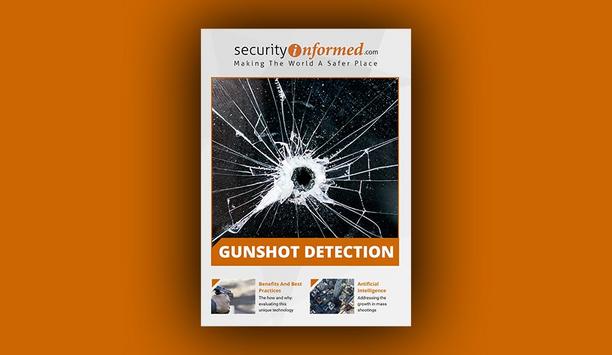
Gunshot Detection
Download